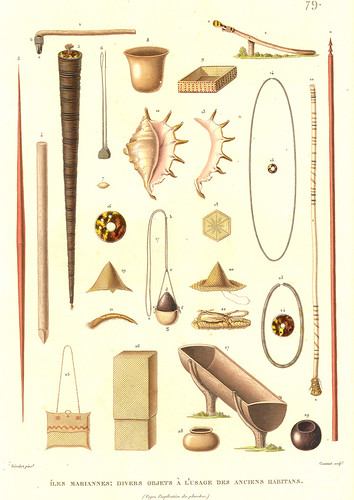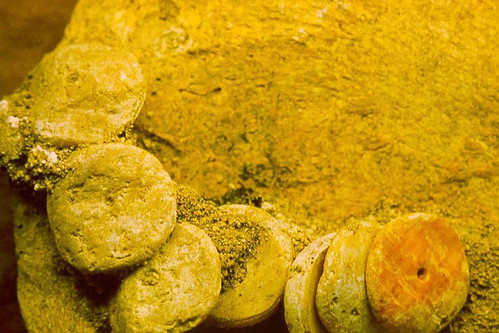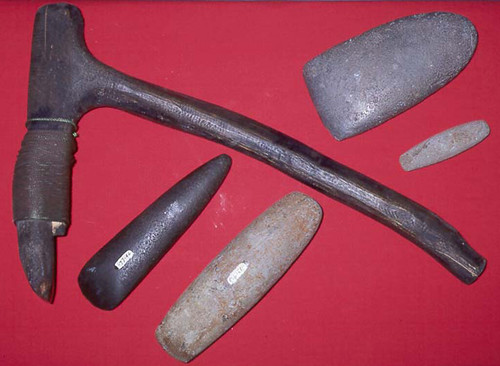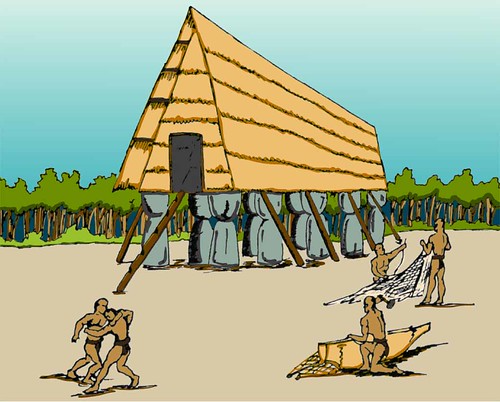Contents of a Latte Village
An interpretive essay
When European explorers of the 16th and 17th centuries visited the Mariana Islands, they witnessed impressive CHamoru villages built during the Latte Period, between AD 800-1700. Many of these settlements, particularly along the coasts, grew from earlier villages before the advent of latte.
Some of these early European visitors to the islands described the villages and the structures they saw. For example, in 1565 the Spanish explorer Miguel Lopez Legaspi provided what may be the first description of a CHamoru village. Although very brief and lacking detail, his statement mentions the use of latte as house supports and the presence of other structures such as canoe houses, meeting houses and cookhouses.
In 1600s the Spanish priest Juan Pobre de Zamora estimated that about 400 pueblos or village were present on Guam. In the 1670s Father Diego Luis de San Vitores stated that the size of villages (defined by the number of casas or houses) varied by location. That is, larger villages with between fifty-150 houses existed along the coast while smaller villages, with six to twenty houses, were located inland. It is unclear whether San Vitores was referring to residences or all structures.
No detailed, written accounts of latte villages are known. Therefore, archaeological research has played an important role in providing a more detailed view of villages during the Latte Period.
Latte
Megaliths known as latte, or two parallel rows of stone pillars, dominated the archaeological landscape of the Mariana islands. When in use, a semi-hemispherical capstone topped each pillar and served as supports for the raised floor of the residence.
Five size classes of latte have been identified, each class defined by the total number of pillars: 6 pillars (three per row), 8 pillars (four per row), 10 pillars (five per row), 12 pillars (six per row) and 14 pillars (seven per row). The classes are not simply the result of adding additional pillars to smaller latte: the more pillars, the taller they are.
Some archaeologists believe that latte supported only the residences of high-status people and that people of lower status lived in houses either on the ground or on wooden pillars. Others have proposed that latte supported the residences of all members of CHamoru society during the Latte Period and that size classes reflected social distinctions. Archaeological excavations have shown that, regardless of size, latte sites tend to contain a wide range of cultural materials. This includes artifacts such as pottery sherds and stone flakes as well as refuse consisting of non-human bone and marine shell. That is, items used on a daily basis.
Cookhouse mounds
Cookhouses, as a structure separate from residences, are common throughout the Pacific. Although historic documents mention their presence in latte villages, no information regarding the size, shape or location (within a village) of these cookhouses was provided. Legaspi suggests that latte were not part of these structures.
Fortunately, archaeological excavations have provided some detail regarding cookhouses. Archaeologically, cookhouses are represented by the presence of low mounds, raised through accumulation of food processing and/or cooking debris such as fish bone, shell, charcoal, tools and pottery sherds. Most importantly, excavations in mounds have revealed the presence of well-formed hearth features. These have been reported as stone-lined ash and charcoal layers.
Canoe house
Throughout Micronesia, canoe houses represent one of the most important structural components of the traditional village. While this certainly remains true for Guam, we have few historical accounts of canoe houses and even less archaeological information.
It is commonly thought that canoe houses in the Mariana Islands were built upon latte, the long axis of which was oriented perpendicular to the shoreline or inland waterway, depending upon the location of the village. This differed from residential latte structures which were oriented parallel with the shorelines. However, this view relies on a series of flawed information:
- mis-translation of Legaspi’s account, because Legaspi never stated that canoe houses were built on latte
- misinterpretation of archaeological observations since Hans G. Hornbostel never claimed that canoe houses were on latte oriented perpendicular to the shore
- latte oriented perpendicular to other latte in a village do not occur in every settlement and, in fact, rarely occur at all
- the width between rows of pillars is too narrow for a canoe to fit.
It is more likely that large wooden structures built directly on the ground functioned as canoe houses. Thus far, archaeological investigations in the Marianas have not given researchers very much information regarding canoe houses.
Public buildings
The Spanish priest Juan Pobre de Zamora used the term camarines to describe large, barn-like buildings he saw during his seven-month stay in the Marianas in 1601. This term also appears in other Spanish documents to describe boathouses as well as other large structures.
It is unclear from early historical accounts if canoe houses served a dual purpose; that is, to provide shelter for canoe as well as a space for public use. Although, in 1678 Padre Solozano stated that each village contained at least one public house usually associated with young men or uritaos (unmarried men) of a village. The more populous villages may have had two of these structures. San Vitores also mentions the “public houses’ of the uritaos.
Archaeological documentation of special-activity structures is rare in the Marianas. A partially disturbed latte at the Pagat site on the northwest coast of Guam exhibited a large sample of fishing equipment including gorges, hooks, bone lure points, a possible Tridacna shell shank and net weights from the Latte era. Bone needles and awls were also recovered. While these implements may have served a variety of functions, the manufacture and repair of fishing nets was one of them.
Excavations on a site located on the north coast of Rota revealed an area containing large numbers of fishing equipment. Hooks and gorges were the most common formal artifact classes recovered from this area. Slightly more than 100 examples were found and most (83 percent) were unfinished. A base fragment of a broken bone fishing lure tip was also recovered. Other artifacts in this area included tools used for manufacturing purposes such as files, abraders and the debris from this production, such as stone debitage and shell. However, there is no evidence that this area was directly associated with latte. The nearest latte was more than forty meters to the east.
At both of these sites, many of the formal artifacts represent various stages of manufacture. Given the apparent focus on the manufacturing of fishing equipment but also containing a range of artifacts such as adzes and sling stones, these areas may have been guma uritao (men’s houses). That these areas were canoe houses is unlikely given the rocky, elevated position both had above and about 100 meters from the ocean.
Summary
A complex mixture of many parts constitutes the latte village. The all too brief historic accounts mention that villages contained several types of structures: residences, cookhouses, men’s house and canoe houses. Archaeological research has provided further information and has supported the historical accounts indicating a variety of structures within a village. As more archaeological information is found, a clearer picture of these settlements is emerging.
For further reading
Carson, Mike T., ed. “Archaeological Studies of the Latte Period.” Micronesica 42, no. 1/2 (2012): 1-79.
Craib, John L. “Casas de los Antiguos: Social Differentiation in Protohistoric Chamorro Society, Mariana Islands, Micronesia.” PhD diss., University of Sydney, 1986.
Graves, Michael W. “Organization and Differentiation within Late Prehistoric Ranked Social Units, Mariana Islands, Western Pacific.” Journal of Field Archeology 13, no. 2 (1986): 139-154.
Plaza, Felicia. “Latte of the Marianas.” Guam Recorder 3, no. 1 (1973): 6-9.
Thompson, Laura. “The Function of Latte in the Marianas.” The Journal of the Polynesian Society 49, no. 195 (1940): 447-465.






